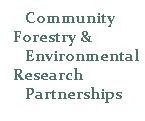|
Why participatory research?
“I have lived in the Cache Creek watershed for most of my life. At last, I have an invitation to be part of the solution to problems of which I have been peripherally aware for over 30 years. It feels good to be involved
with something so central to the healing of the land and the people.”
--Jacquelyn Ross, Community Partner and Steering Committee Member
of the Native American Tending and Gathering Garden at the
Cache Creek Nature Preserve, Woodland , CA .
Participatory research is a key component to CFERP’s goal of advancing community-based natural resource management (CBNRM) for two major reasons. First, CBNRM efforts need solid information. The best efforts of communities to sustain their local forests and watersheds while simultaneously providing for the well being of their own residents will falter if they are not built on sound information. Second, to be successful, conservation programs must be sensitive to local cultural and social needs and realities. Therefore, collaboration among communities, professionals, and academics is critical, as is networking with peers from other communities and organizations to share experiences, techniques, and knowledge.
Principals of Participatory Research
In an extensive synthesis of community-based and participatory research literature, Israel et al (1998) propose the following key principles of community-based research. These can be taken as a starting point but are by no means definitive:
- Recognizes community as a unit of identity. This research should work explicitly with communities, which may be defined by a geographic area, or defined as a community of identity that is geographically dispersed but members hold a sense of common identity and shared fate.
- Builds on strengths and resources within the community . This research should explicitly identify, support and reinforce social structures, processes, and knowledge already existing in the community that help them work together to improve their lives.
- Facilitates collaborative partnerships in all phases of the research. This research should involve community members in every phase they want to participate in, including but not limited to: problem definition, data collection, interpretation of results, and application of the results to address community concerns. This may involve applying skills from outside the community, but should focus on issues identified by the community and create situations in which all parties can truly influence the entire research process.
- Integrates knowledge and action for mutual benefit of all partners. Though the research project itself might not include a direct action component, all parties must have a commitment to applying the research results to a social change effort intended to benefit all partners.
- Promotes a co-learning and empowering process that attends to social inequalities. This research should recognize the inherent inequalities between marginalized communities and researchers, and attempt to address these by emphasizing knowledge of community members and sharing information, resources and decision-making power. Israel et al offer the example that researchers learn from the knowledge and local theories of the community members, and community members acquire further skills in how to conduct research.
- Involves a cyclical and iterative process. This research should involve trust-building, partnership development and maintenance in all phases of the research.
- Disseminates findings and knowledge gained to all partners . This research should disseminate information gained in a respectful and understandable language that acknowledges all participants contributions and ownership of the knowledge production.
Israel , Barbara; Amy Schultz; Edith Parker and Adam Becker. 1998. Review of Community-Based Research: Assessing Partnership Approaches to Improve Public Health. Annual Review of Public Health 19: 173-202.
Participatory Research Materials
For the past several years, at each annual workshop we have taken time to discuss participatory research and how it pertains to the work our fellows do in the field. We discuss the basic concepts, the history, how to involve the community, critical issues and constant and inherant questions about doing participatory research.
For more information on each of these topics, please click on the links below for the handouts we use during this workshop.
Several of these are in PDF format and can be read using Adobe's free Acrobat Reader. To download Acrobat Reader, visit http://www.adobe.com.
|







